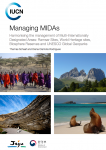The 2016 International Union for the Conservation of Nature (IUCN) World Conservation Congress (WCC) has reviewed a "Guidance" report highlighting some benefits and challenges associated with conservation sites around the world that are covered by multiple international designations.
The publication, titled ‘Managing MIDAs – Harmonising the management of Multi-Internationally Designated Areas: Ramsar Sites, World Heritage sites, Biosphere Reserves and UNESCO Global Geoparks,' draws on 11 case studies from around the world.
 4 September 2016: The 2016 International Union for the Conservation of Nature (IUCN) World Conservation Congress (WCC) has reviewed a “Guidance” report highlighting some benefits and challenges associated with conservation sites around the world that are covered by multiple international designations. The publication, titled ‘Managing MIDAs – Harmonising the management of Multi-Internationally Designated Areas: Ramsar Sites, World Heritage sites, Biosphere Reserves and UNESCO Global Geoparks,’ draws on 11 case studies from around the world.
4 September 2016: The 2016 International Union for the Conservation of Nature (IUCN) World Conservation Congress (WCC) has reviewed a “Guidance” report highlighting some benefits and challenges associated with conservation sites around the world that are covered by multiple international designations. The publication, titled ‘Managing MIDAs – Harmonising the management of Multi-Internationally Designated Areas: Ramsar Sites, World Heritage sites, Biosphere Reserves and UNESCO Global Geoparks,’ draws on 11 case studies from around the world.
The publication notes that 263 areas out of the current list of 238 natural World Heritage sites, 2,241 Ramsar sites, 669 Biosphere Reserves and 120 UN Educational Scientific and Cultural Organization (UNESCO) Global Geoparks carry “double, triple or even quadruple international designations.”
The Guidance emanated from a resolution adopted at the 2012 IUCN WCC that highlighted the vulnerability of protected areas on Jeju Island in the Republic of Korea, which is visited by more than 10 million tourists annually, and where all four international designations are superimposed. The resolution expressed concern that the different management guidelines, time cycles and periods provided and monitored by the four different designating authorities “impedes the establishment of a comprehensive management regime.” The WCC described the integrated management system of UNESCO international protected areas as “the most assured method for conservation of wild fauna and flora,” further noting that this approach “complies with the fundamental concept of IUCN and contributes to the sustainable use of ecosystems.”
Among follow up actions, the resolution called on the IUCN Director-General, “based on the learnings of the Jeju experience and in cooperation with all relevant stakeholders,” to develop an integrated conservation management manual that includes guidelines and other prescriptions for the systematic conservation and sustainable use of ecosystems. It also called for IUCN to develop and standardize a management system for protected areas, “including the integration of the different cycles for re-evaluation of designations,” and to distribute it as a model for IUCN Members.
IUCN subsequently prepared the Guidance, in close collaboration with UNESCO and the Ramsar Convention on Wetlands, and with support from the Republic of Korea’s Jeju Special Self-Governing Province and Ministry of Environment.
The report provides an overview of the respective international designating bodies, summarizing different aspects of the four designations, such as their purposes, main objectives, history, legal frameworks, administrative arrangements, governance structures and bodies, reporting and monitoring requirements, as well as their scientific advisory bodies and governmental obligations. It provides recommendations for harmonizing the management, systematic conservation and sustainable use of these areas aimed at the local, national and international stakeholders of MIDAs.
Among specific recommendations, the Guidance calls for the joint creation and maintenance of an online list of MIDAs, ideally integrated within the IUCN/UNEP-WCMC (UN Environment Programme-World Conservation and Monitoring Centre) World Database on Protected Areas, “as a basic requirement for collaboration,” and notes that this is consistent with the clearing-house function of the four secretariats.
In other recommendations targeted at the four international designating bodies, the Guidance calls for, among other actions: reviewing existing cooperation agreements and, where appropriate, updating these to ensure complementary support for the benefit of MIDAs; holding regular meetings among the secretariats and participating in each other’s governing meetings in order to increase information flow and coherence on policy decisions affecting MIDAs; establishing harmonized reporting processes for MIDAs to enhance efficiency as well as the quality of reports and facilitate joint technical assessments and monitoring; and developing harmonized branding and communication strategies for their respective designations that highlight the added value of each designation and their potential for cooperation and synergistic activities.
The Guidance further calls for the four bodies to hold joint capacity-building activities for site managers, national focal points, and other relevant stakeholders on the specific profiles of each designation. It notes that these should aim to foster possible synergies among the international instruments, and facilitate the exchange of best practices in the management of MIDAs.
Han Qunli, Secretary of UNESCO’s Man and the Biosphere (MAB) Programme, described the publication as the first comprehensive report on the management of MIDAs, and noted that the recommendations will help to mitigate possible duplication and confusion at different levels of conservation work, “and thus protect the specific focus and brand recognition of each designation.”
Noting that internationally designated areas must be models of conservation, demonstrating the highest standards and quality of management, Peter Shadie, head of the IUCN delegation for World Heritage at the IUCN Congress stated that when these areas have multiple designations, “they have an even greater potential to inspire best practice for protected areas in the face of global challenges.”
Martha Rojas-Urrego, Secretary General of the Ramsar Convention on Wetlands, described the Guidance as a “much needed contribution and tool” to support more integrated and effective management of MIDAs.
The WCC is convening under the theme, ‘Planet at the Crossroads,’ in Honolulu, Hawai’i, the US, from 1-10 September 2016. [Ramsar Convention Press Release] [UNESCO Press Release] [Managing MIDAs – Harmonising the management of Multi-Internationally Designated Areas: Ramsar Sites, World Heritage sites, Biosphere Reserves and UNESCO Global Geoparks] [IISD RS Coverage of the IUCN World Conservation Congress]